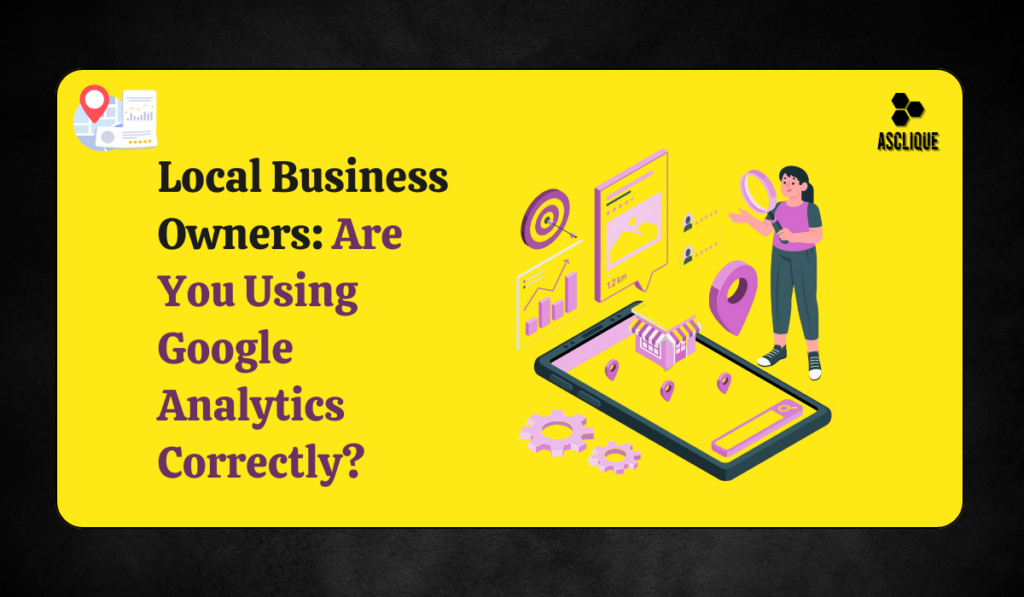Local SEO is imperative for companies that rely on local customers. If you have a local restaurant, law firm, or retail store, being higher up on local search can bring foot traffic, calls, and site visits. But without monitoring and tracking your data, you’ll never know what works and doesn’t work. That is where using Google Analytics for local SEO takes center stage as an important local SEO component.
This article will cover:
- Why Google Analytics is critical to get local SEO to work
- Is Google Analytics or Google Search Console better for local SEO?
- A step-by-step guide to setting up Google Analytics for local SEO
With this guide, you will have all the knowledge needed to use Google Analytics for local SEO to track traffic, make local searches optimized, and bring your business to the limelight.
Why Google Analytics is an Essential Tool for Achieving Local SEO Success
Google Analytics provides companies with useful information to gauge local SEO success. Knowing local search traffic, knowing how users act and convert, Google Analytics provides information that can boost a company’s online presence.
1.1 Tracking Local Website Traffic
Being aware of where your traffic is coming from is perhaps the most essential local SEO idea. Google Analytics categorizes traffic sources, and you can monitor:
- Organic traffic – People who came to your site via a search engine such as Google.
- Direct traffic – Individuals who entered your website URL directly into a browser.
- Referral traffic – Individuals who came to your website via clicks on other websites’ links, including local listings (e.g., Yelp, Google My Business).
- Social traffic – Individuals who came to your site from social websites such as Facebook, Instagram, or Twitter.
How to see this in Google Analytics:
- Log into Google Analytics.
- In Google Analytics, open Acquisition > All Traffic > Channels.
-
Look at Organic Search, Referral, and Direct traffic to see how visitors reach your business.
Through tracking these, you can gauge how effective your local SEO campaigns are and where you need to improve.
1.2 User Behavior
Google Analytics provides insights into how users engage with your website. Key behavior metrics are:
- Bounce Rate – The number of visitors that bounce from your site after viewing only one page. A high rate might mean your site isn’t giving users the information they want.
- Session Duration – The average time a visitor stays on your site. Greater durations show increased engagement.
- Pages per Session – How many pages per session a visitor views. The greater the number of pages, the more users are interested in your content.
To analyze user behavior:
- Visit Behavior → Site Content → Landing Pages.
- Notice which pages are most visited and what the users do when they are there.
- Improve poorly performing pages by adding more content, internal link building, and speeding up the page.
1.3 Tracking Local Conversions and ROI
Local SEO isn’t about generating traffic; it’s about making browsers into buyers. Google Analytics provides tracking of the following actions:
- Phone calls – Mobile click-to-call actions.
- Contact form submissions – Inquiries from lead customers.
- Store visits – Target clicks or Google Maps direction clicks.
To track those conversions:
- Administrative → View → Goals.
- Hit New Goal and select a relevant goal type (e.g., phone call, form submission).
- Monitor the success of these goals under Conversions → Goals → Overview.
Conversions tracking enables companies to gauge their Return on Investment (ROI) from local SEO campaigns and make informed decisions based on data.
1.4 Identifying High-Performing Local Keywords
Google Analytics aids businesses in recognizing what search phrases garner the highest traffic. Although Google does not reveal full keyword information due to privacy regulations, Google Search Console can be included to ensure you can access the most useful keyword data.
To retrieve keyword data:
- Connect Google Search Console to Google Analytics.
- Press the path Acquisition → Search Console → Queries.
- Review the keywords that generate local traffic and tune the pages.
High-performing title tags, meta descriptions and keywords can have a dramatic impact on local rankings.
Google Analytics vs. Google Search Console: What’s Better For Local SEO?
Google Analytics and Google Search Console, although for different reasons, are in harmony with each other to support local SEO optimization.
2.1 Google Analytics: Measuring On-Site Behavior
Google Analytics provides information about how users interact with your website.
- Traffic Sources: Organic, Direct Referral, Social, Paid
- User interaction (bounce rate pages per session, session length.)
- Conversions – form submissions phone calls, transactions.
Google Analytics is the cornerstone of understanding your customer’s behavior and making sure your website is optimized for local search.
2.2 Google Search Console: Evaluating Search Visibility
Google Search Console is assisting companies to assess their search performance within Google results. It offers insights on the following:
- Search queries driving traffic onto your site
- Click-through rates from search results
- Indexing problems and mobile usability faults
- Backlink profile and external links
Google Search Console is most important in holding search ranks and solving SEO problems impacting local visibility.
2.3 Which One is Better for Local SEO?
Both of these are important for local SEO, but they perform different functions.
- Google Search Console is for improving search visibility, resolving issues, and analyzing keyword ranking.
- Google Analytics allows you to assess user behavior, conversions, and overall website performance.
- Both are integrated for a complete insight into how local customers discover and interact with your website.
Step-by-Step Guide to Setting Up Google Analytics for Local SEO

Google Analytics Configurations for Local SEO enable businesses to follow through the performance of a website, assess user engagement, and optimize strategies for better visibility in local search. Follow these steps to configure Google Analytics for Local SEO.
Creating an Account for Google Analytics
To begin monitoring local SEO parameters, you must create a Google Analytics account:
- Go to the Google Analytics website.
- Click on Start Measuring and sign in using a Google account.
- Provide your business name, website URL, and industry category.
- Choose Google Analytics 4 (GA4) as the property type.
- Creating means that you accept the terms and conditions.
Adding Google Analytics to Your Website
Once you’ve done that, Google Analytics will then offer you a tracking ID (like G-XXXXXXXXXX). Below is how to install it onto your website:
- Copy the tracking code from the page on Google Analytics.
- Copy it into the head of the page on your website or embed it using Google Tag Manager.
- Verify if you have properly installed it by entering the Real-Time Reports on Google Analytics and checking if your activity gets reported there.
Setting Up Goals in Local SEO
Measuring local SEO goals assists in the inventorying of user interaction, which can range from phone calls to contact forms filled in or visits to the store.
- Go to Admin and then to Goals under View.
- Click on New Goal and select an appropriate template such as Phone Call or Contact Form Submission.
- Enter the destination URL (such as “/thank-you”) that signals completed actions to track.
Google Search Console setup with Google Analytics
Business owners analyze keyword ranks and local search performance via the combined utilization of Google Search Console.
- Visit Property Settings: Admin → Property Settings → Change Search Console.
- Click on Add a Search Console Property and do ownership verification as offered.
- Visit Acquisition → Search Console after connection to view keyword data and search performances.
Setting Up Local SEO Reports
Custom reports allow tracking of some of the key local SEO metrics like organic traffic, bounce rates, and conversions.
- Go to Customization → Custom Reports.
- Click Create a New Report and add the relevant metrics.
- Track performance indicators such as organic search traffic, user location, and goal conversions.
- Save the report and revise it on a weekly basis to improve local SEO strategies.
With the proper set-up for Google Analytics, companies are in a good position to monitor and improve their local SEO tasks to gain better visibility and greater customer engagement.
Conclusion
Google Analytics is the tracking divisor used for local SEO to assess website traffic behavior and conversion. In contrast, Google Search Console gives websites the power to improve search rankings; hence, Analytics explains how the visitor acts upon a site in more detail. Correctly setting up Google Analytics, tracking the key metrics, Google Search Console integration enables businesses to take data-driven decisions for enhancing local search rankings and gaining more local customers. Thus, local SEO success demands a continuous analysis and optimization. Google Analytics is the convoy you need to face the competition in the local search world.
FAQs
How does Google Analytics assist in enhancing local SEO?
With Google Analytics, businesses have a way of monitoring the sources from which they receive local traffic, analyzing customer behavior, and measuring conversions such as phone calls and form submissions. Google Analytics tells businesses which keywords and pages are attracting the most local customers and which marketing strategies work best, so they can strengthen their local SEO efforts.
What are the differences between Google Analytics and Google Search Console when it comes to local SEO?
Google Analytics: Tracks the user behavior, traffic, session time, and conversion. Google Search Console: Helps a company stay ranked for searches by solving the issues related to indexing as well as track the keyword rank. Both these computer programs have to be implemented if you have to excel in Local SEO.
How can I track local search traffic on Google Analytics?
To monitor the local search traffic, implement the following:
- Log in to Acquisition → All Traffic → Channels on Google Analytics.
- Click Organic Search to view search engine traffic.
- Choose Location Filters under Audience → Geo → Location to restrict attention to traffic from certain local areas.
How do I set up a Google Analytics account to monitor the local SEO conversions?
To monitor conversions:
- Visit Admin → View → Goals in Google Analytics.
- Click New Goal and choose a goal type (phone calls, form submissions, etc.).
- Enter the target URL (thank you page) or event tracking click to call.
- Save and track conversions under Conversions → Goals → Overview.
Why integrate Google Search Console with Google Analytics for local SEO?
Merging Google Search Console with Google Analytics gives the company access to search queries, keyword performance, and click-through rate in Analytics. This helps to optimize content, target the optimal keywords, and enhance local search rankings.

